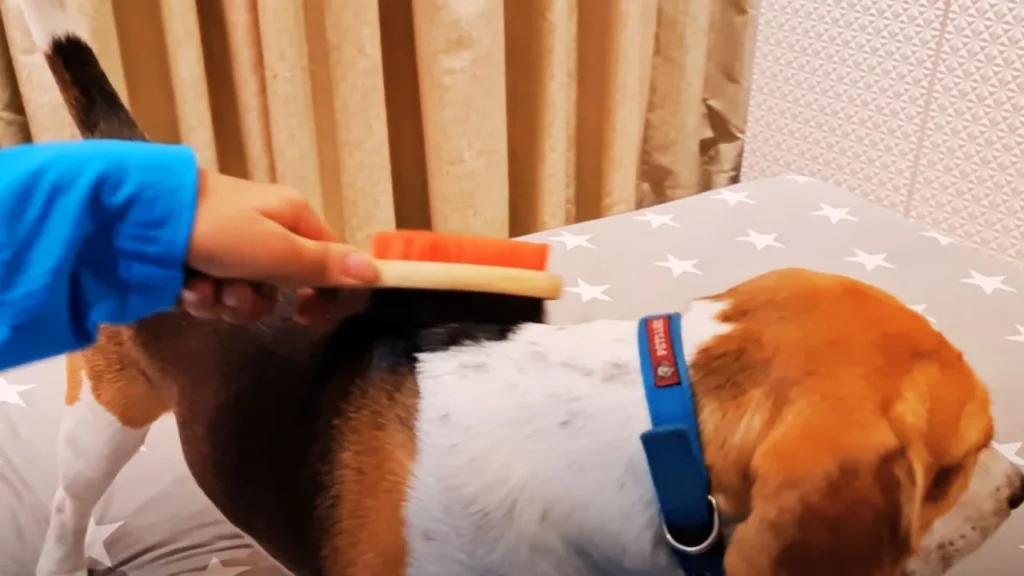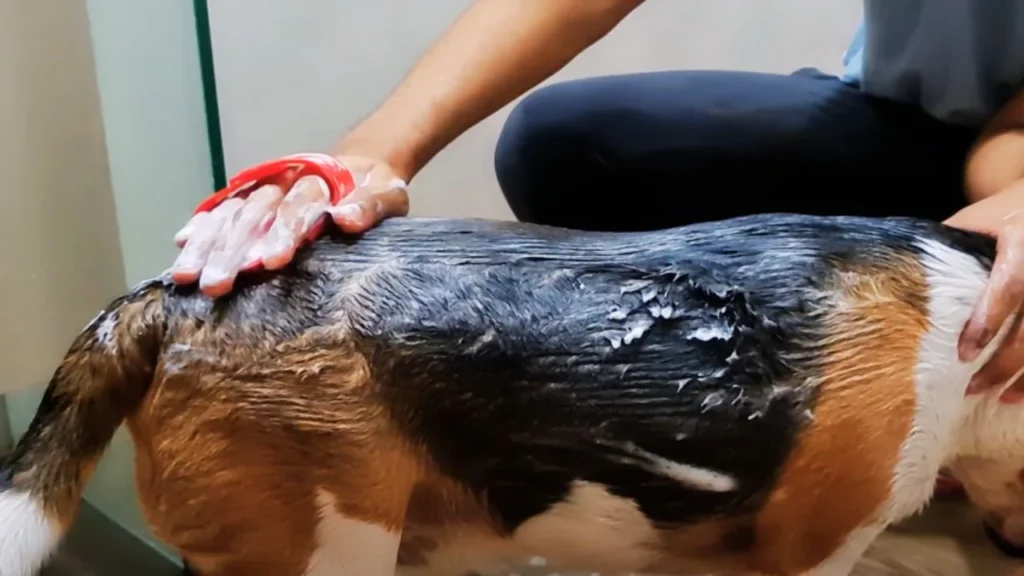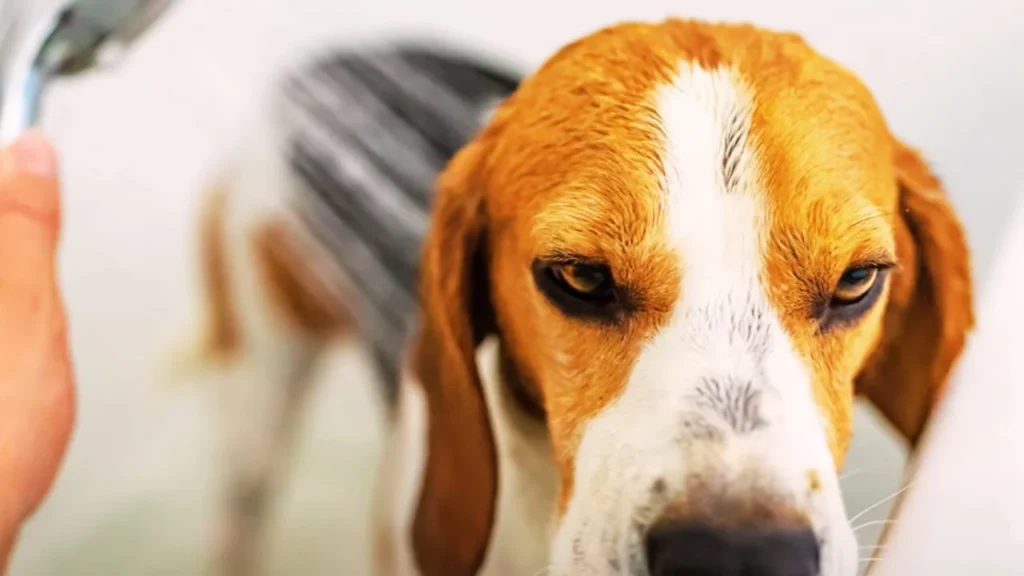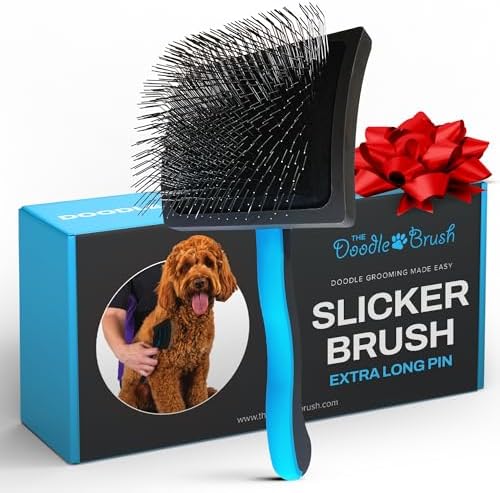Beagles have short, dense double coats that require regular grooming to maintain their health and appearance. Brushing helps remove loose hair, prevents tangles, and distributes natural oils across the skin, promoting a shiny, healthy coat. The best brush for beagles is a slicker brush or a bristle brush, as these effectively manage their coat type. So, what tools should I use to brush my beagle?
But with so many grooming tools available, it’s important to choose the right ones for your Beagle’s specific needs. Let’s break down the best brushes and grooming tools for Beagles in our detailed guide on the best dog brush for Beagles, along with some helpful tips for optimal care. Learn the best practices for putting a collar on thick-skinned dogs to ensure a comfortable and irritation-free fit.
What Should I Brush My Beagle With?
The Best Brush for Beagles

What should I brush my beagle with? Brush your Beagle with a bristle brush for regular maintenance, a rubber grooming mitt for gentle massaging, and a de-shedding tool during shedding seasons. A bath brush helps during baths to clean thoroughly and reach the skin. Regular grooming keeps your Beagle’s coat healthy and shiny.
Here’s a quick table on What Should I Brush My Beagle With:
Types of Brushes for Beagles
Beagles have a double coat, consisting of a soft undercoat and a coarser topcoat. Choosing the right brush ensures that both layers are properly cared for, which is important for maintaining their overall skin and coat health.
- Bristle Brush: This is a must-have for Beagle owners. A medium-bristle brush is perfect for regular use, helping to remove loose hair and dirt. It’s gentle enough to use frequently, while effectively distributing natural oils, keeping your Beagle’s coat looking glossy. Bristle brushes come in varying sizes, so make sure to choose one that’s appropriate for your dog’s size (larger for adults, smaller for puppies.
- Rubber Grooming Mitt: Ideal for Beagles who are a bit hesitant about grooming. The rubber fingers on these mitts gently massage your dog while catching loose hair, making it a calming experience for both of you. This type of mitt is particularly good for massaging the skin and stimulating circulation.
- De-shedding Tool: For shedding seasons, a de-shedding tool, like the FURminator or an undercoat rake, is essential. These tools are designed to reach deeper into the coat to pull out dead hairs that are trapped in the undercoat, which can reduce shedding and keep your home cleaner. This is particularly helpful during heavy shedding periods.
How Often Should You Brush Your Beagle?
Beagles should be brushed at least once or twice a week to maintain a healthy coat. However, during shedding seasons (typically in the spring and fall), you may need to brush them more frequently to manage the increased hair loss. If you’re wondering how Beagles compare to another popular breed, check out our detailed comparison on whether a Beagle or a Labrador is the better choice in our guide on Beagle vs. Labrador. Regular brushing also helps to reduce the risk of hair matting, especially on the undercoat, which can trap dirt and debris.
Bath Brush for Thorough Cleaning
While Beagles don’t require frequent baths (usually every 4-6 weeks), using a bath brush can help during bathing. A bath brush ensures the shampoo reaches the undercoat and thoroughly cleans your dog’s skin, removing accumulated oils and dirt. After a bath, brushing with a bristle brush helps smooth the coat and gives it a neat finish. For a detailed guide on how to train a Bull Terrier with the right collar, check out this comprehensive article that outlines effective steps and techniques.
Other Essential Grooming Tools
- Grooming Mitt or Glove: This is useful during heavier shedding seasons. It gently pulls out dead hairs while massaging your dog, providing a comforting grooming experience.
- Leave-in Conditioner and Spray: After a grooming session, you can opt for a light spritz of a leave-in conditioner to keep the coat soft, moisturized, and smelling fresh. This also helps reduce dandruff and dry skin.
- Ear and Eye Cleaning Tools: Beagles are prone to ear infections due to their floppy ears. Using a vet-approved ear-cleaning solution along with cotton balls is essential for maintaining ear hygiene. For eyes, canine eye wipes can keep the area clean and free from discharge.
How to Make Brushing a Positive Experience?
Beagles can sometimes be stubborn, so it’s essential to make grooming a pleasant and stress-free experience:
- Start Early: Begin grooming your Beagle at a young age to get them accustomed to the process. This builds trust and ensures they don’t become anxious during grooming sessions.
- Use Gentle Pressure: While brushing, use gentle strokes that allow you to remove loose hair without irritating your dog’s skin. Beagles have sensitive skin, so it’s important not to press too hard.
- Positive Reinforcement: Always reward your dog with treats or praise during and after grooming. This will help them associate brushing with a positive experience, making future sessions easier.
Dealing with Heavy Shedding Periods

Beagles shed more heavily during certain times of the year, such as spring and fall. During these periods, brushing your Beagle with a de-shedding tool or undercoat rake will help remove the excess hair before it ends up all over your house. These tools reach deep into the undercoat and remove dead hair that regular brushes may miss. Determine the ideal collar size for a Bernese Mountain Dog with this guide.
Choosing the Right Grooming Products
While grooming tools are essential, it’s equally important to choose high-quality grooming products for your Beagle’s skin and coat:
- Shampoo and Conditioner: Use a dog-specific shampoo that’s gentle and doesn’t strip away natural oils. Conditioners can add a protective layer to the fur, preventing dryness and maintaining a soft, shiny coat.
- Nail Clippers or Grinders: Beagles’ nails should be trimmed every 3-4 weeks. A nail grinder is often recommended because it allows for better control, reducing the risk of cutting too close to the quick.
Grooming Your Beagle’s Coat: Preventing Common Issues and Maintaining Health

Maintaining your Beagle’s coat isn’t just about aesthetics; it’s also about keeping your dog healthy and comfortable. Regular grooming can prevent skin problems, improve circulation, and help identify potential health issues before they become serious. Here’s how to tackle common coat-related issues and ensure that your Beagle stays in top condition.
1. Preventing Shedding Issues
Beagles are known to shed year-round, with heavier shedding occurring during spring and fall when they “blow” their coats. During these shedding seasons, loose fur can get trapped in the undercoat, causing discomfort, tangling, and potential skin problems if not managed properly.
Using a de-shedding tool like the FURminator or an undercoat rake is crucial during this time. These tools can reach the dense undercoat and remove trapped hair that would otherwise end up on your furniture or cause matting.
Regular brushing with a bristle brush or a grooming mitt in addition to using a de-shedding tool helps reduce the amount of loose fur, making it easier to manage shedding and keep your home cleaner.
2. Addressing Dry Skin and Dandruff
Dry skin and dandruff are common in Beagles, especially in colder or dryer climates where the humidity is low. Regular brushing helps distribute the natural oils in their skin, preventing dryness. For additional protection, you can use a leave-in conditioner after brushing to keep the skin moisturized and the coat soft. This also helps prevent dandruff and reduces irritation from dry skin.
Bathing your Beagle with a high-quality, dog-specific shampoo once every four to six weeks also helps. Avoid human shampoos as they can strip away the natural oils from your Beagle’s skin, worsening the dryness. Look for shampoos with ingredients like oatmeal or aloe, which soothe and hydrate the skin. Explore if mountain dogs are good pets and suitable for your home.
3. Spotting and Addressing Skin Conditions
Brushing your Beagle provides a great opportunity to check for skin abnormalities like rashes, redness, or lumps. Skin issues, such as hot spots, infections, or parasite infestations, are easier to catch during grooming sessions.
Hot spots, which are areas of irritated, inflamed skin, can occur due to allergies, moisture trapped in the fur, or excessive licking. If you notice any abnormalities, it’s important to consult your vet early before the issue escalates.
Another common issue Beagles face is flea and tick infestations, particularly if they spend a lot of time outdoors. Regular brushing allows you to spot these parasites before they cause major discomfort or health issues. Using a flea comb during grooming can help remove these pests, and applying vet-recommended flea and tick prevention treatments will keep your Beagle protected.
4. Handling Sensitive Areas
While Beagles have short coats, certain areas like their underbelly, armpits, and ears can still be sensitive and prone to irritation. When grooming these areas, it’s important to use a soft-bristle brush or grooming mitt to avoid causing discomfort. If your Beagle shows signs of sensitivity or pain, reduce pressure or switch to a gentler grooming tool.
For areas like the ears, which are prone to infection due to their floppy nature, regular cleaning with a vet-approved ear solution is necessary. Use a soft cloth or cotton ball to gently clean the outer ear, but avoid inserting anything into the ear canal. Regular ear checks and cleaning will prevent infections and keep your Beagle comfortable.
5. The Role of Nutrition in Coat Health
A Beagle’s diet plays a significant role in maintaining a healthy coat. Feeding your Beagle a balanced diet rich in omega-3 and omega-6 fatty acids can promote healthy skin and reduce shedding. Foods with these nutrients help maintain the skin’s moisture barrier, preventing dryness and keeping the coat shiny.
If your Beagle suffers from chronic skin problems, a dietary supplement or specially formulated dog food may be necessary to address deficiencies. Consulting your vet about your Beagle’s diet can provide insights into how to improve their coat’s health from the inside out. Find out whether collars are bad for a dog’s neck and fur and how to avoid common issues.
Wrapping Up:
Regular grooming with the right tools and products is key to keeping your Beagle happy and healthy. A combination of a medium-bristle brush, grooming mitt, and de-shedding tool will help maintain their coat, while additional grooming practices like ear cleaning, nail trimming, and using quality shampoos will ensure your Beagle looks and feels their best.
Whether it’s a weekly brushing session or a full grooming routine, these steps will help you build a stronger bond with your Beagle and keep them comfortable and clean year-round. Hope so, now you know, what should I brush my beagle with? Learn if it’s bad to leave a dog’s collar on all the time and how to ensure your pet’s comfort.




